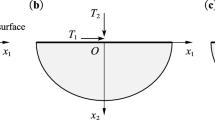Abstract
We present a linear numerical scheme for a model of epitaxial thin film growth without slope selection. The PDE, which is a nonlinear, fourth-order parabolic equation, is the L 2 gradient flow of the energy \(\int_{\Omega}( - \frac{1}{2} \ln(1 + |\nabla\phi|^{2} ) + \frac{\epsilon^{2}}{2}|\Delta\phi(\mathbf{x})|^{2})\,\mathrm{d}\mathbf{x}\). The idea of convex-concave decomposition of the energy functional is applied, which results in a numerical scheme that is unconditionally energy stable, i.e., energy dissipative. The particular decomposition used here places the nonlinear term in the concave part of the energy, in contrast to a previous convexity splitting scheme. As a result, the numerical scheme is fully linear at each time step and unconditionally solvable. Collocation Fourier spectral differentiation is used in the spatial discretization, and the unconditional energy stability is established in the fully discrete setting using a detailed energy estimate. We present numerical simulation results for a sequence of ϵ values ranging from 0.02 to 0.1. In particular, the long time simulations show the −log(t) decay law for the energy and the t 1/2 growth law for the surface roughness, in agreement with theoretical analysis and experimental/numerical observations in earlier works.
Similar content being viewed by others
References
Ehrlich, G., Hudda, F.G.: Atomic view of surface diffusion: tungsten on tungsten. J. Chem. Phys. 44, 1036–1099 (1966)
Evans, J.W., Thiel, P.A., Bartelt, M.C.: Morphological evolution during epitaxial thin film growth: formation of 2D islands and 3D mounds. Surf. Sci. Rep. 61, 1–128 (2006)
Eyre, D.J.: Unconditionally gradient stable time marching the Cahn-Hilliard equation. In: Bullard, J.W., Kalia, R., Stoneham, M., Chen, L.Q. (eds.) Computational and Mathematical Models of Microstructural Evolution, vol. 53, pp. 1686–1712. Materials Research Society, Warrendale (1998)
Guan, Z., Wang, C., Wise, S.M.: Convergence of a convex splitting scheme for the nonlocal Cahn-Hilliard Equation (in preparation)
Hu, Z., Wise, S.M., Wang, C., Lowengrub, J.S.: Stable and efficient finite-difference nonlinear-multigrid schemes for the Phase Field Crystal equation. J. Comput. Phys. 228, 5323–5339 (2009)
Johnson, M.D., Orme, C., Hunt, A.W., Graff, D., Sudijono, J., Sander, L.M., Orr, B.G.: Stable and unstable growth in molecular beam epitaxy. Phys. Rev. Lett. 72, 116–119 (1994)
Kohn, R.V.: Energy-driven pattern formation. In: Sanz-Solé, M., Soria, J., Varona, J.L., Verdera, J. (eds.) Proceedings of the International Congress of Mathematicians, vol. 1, pp. 359–383. European Mathematical Society Publishing House, Madrid (2006)
Kohn, R.V., Yan, X.: Upper bound on the coarsening rate for an epitaxial growth model. Commun. Pure Appl. Math. 56, 1549–1564 (2003)
Li, B.: High-order surface relaxation versus the Ehrlich-Schwoebel effect. Nonlinearity 19, 2581–2603 (2006)
Li, B., Liu, J.-G.: Thin film epitaxy with or without slope selection, Euro. J. Appl. Math. 14, 713–743 (2003)
Li, B., Liu, J.-G.: Epitaxial growth without slope selection: energetics, coarsening, and dynamic scaling. J. Nonlinear Sci. 14, 429–451 (2004)
Moldovan, D., Golubovic, L.: Interfacial coarsening dynamics in epitaxial growth with slope selection. Phys. Rev. E 61, 6190–6214 (2000)
Schwoebel, R.L.: Step motion on crystal surfaces: II. J. Appl. Phys. 40, 614–618 (1969)
Wise, S.M., Wang, C., Lowengrub, J.: An energy stable and convergent finite-difference scheme for the Phase Field Crystal equation. SIAM J. Numer. Anal. 47, 2269–2288 (2009)
Wang, C., Wang, X., Wise, S.M.: Unconditionally stable schemes for equations of thin film epitaxy. Discrete Contin. Dyn. Syst., Ser. A 28, 405–423 (2010)
Xu, C., Tang, T.: Stability analysis of large time-stepping methods for epitaxial growth models. SIAM J. Numer. Anal. 44, 1759–1779 (2006)
Author information
Authors and Affiliations
Corresponding author
Rights and permissions
About this article
Cite this article
Chen, W., Conde, S., Wang, C. et al. A Linear Energy Stable Scheme for a Thin Film Model Without Slope Selection. J Sci Comput 52, 546–562 (2012). https://doi.org/10.1007/s10915-011-9559-2
Received:
Revised:
Accepted:
Published:
Issue Date:
DOI: https://doi.org/10.1007/s10915-011-9559-2




